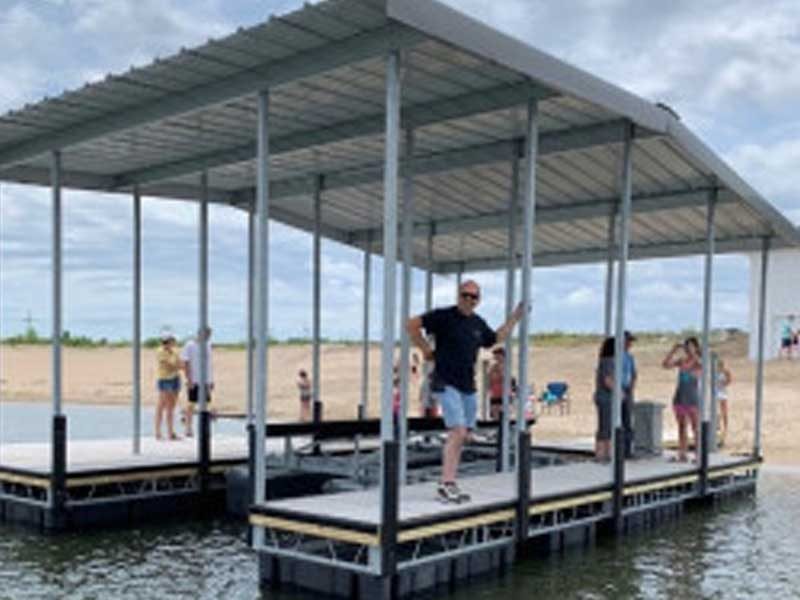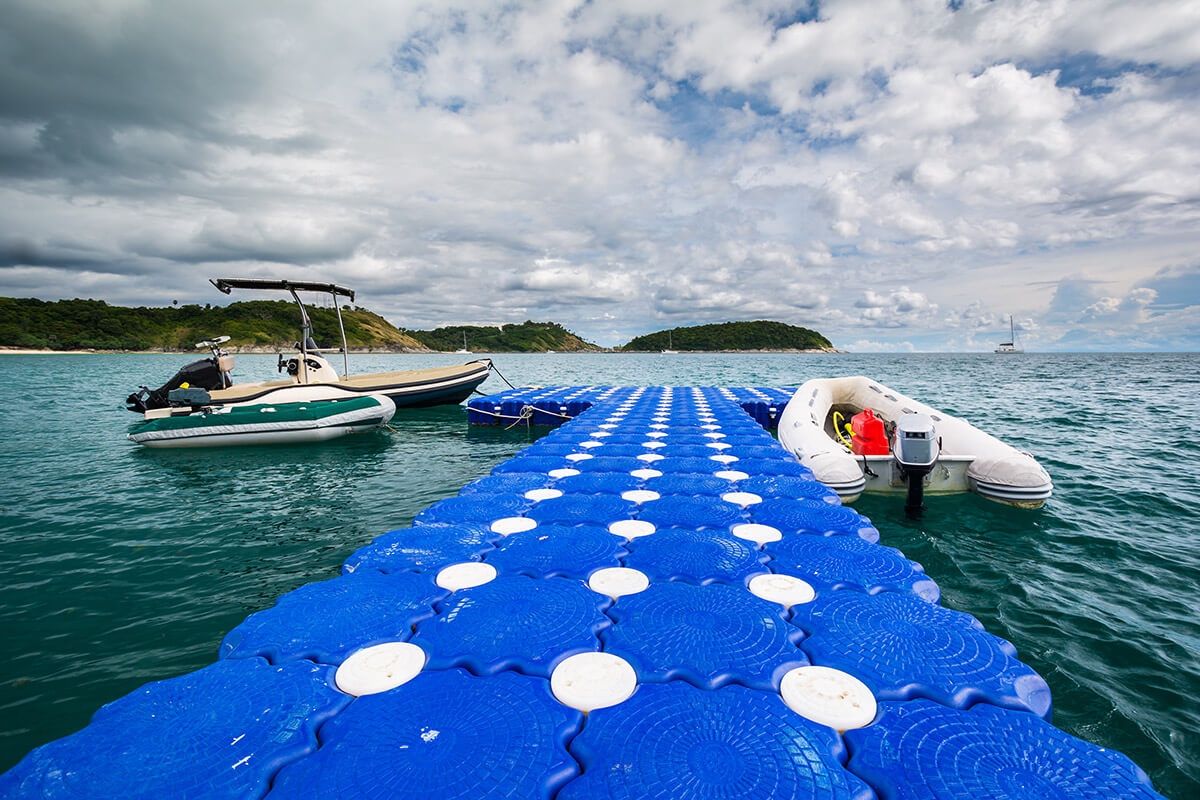Ingenious Floating Docks: The Future of Waterside Access and Recreation
Ingenious Floating Docks: The Future of Waterside Access and Recreation
Blog Article
Develop the Perfect Docking Solution With Floating Docks
Floating docks present a flexible remedy for a variety of maritime requirements, adjusting seamlessly to fluctuating water degrees and varied vessel kinds. Their modular nature allows for fast installation and relocation, yet the selection of proper materials and design attributes is essential for making certain both performance and visual charm. As we check out the essential aspects that add to the efficiency of floating docks, numerous vital aspects regarding security and upkeep will certainly arise, elevating inquiries concerning exactly how to maximize your docking experience. The subsequent conversation will brighten these essential factors to consider.

Advantages of Floating Docks
Floating docks offer many benefits that make them an excellent option for different maritime applications. Among the main benefits is their flexibility to transforming water levels. Unlike fixed docks, floating docks rise and autumn with the trend, ensuring constant availability for vessels. This function is especially crucial in locations susceptible to significant tidal changes or seasonal water degree changes.
In addition, floating docks are generally much easier and quicker to install compared to traditional fixed frameworks. Their modular style permits uncomplicated setting up and disassembly, helping with maintenance and moving when required. This versatility is particularly valuable for short-lived applications or in settings where problems might transform.
Floating docks also often tend to be much more eco-friendly, as they lessen disturbance to the seabed and surrounding aquatic ecological communities. Their resilient nature minimizes the risk of damage to aquatic life, promoting a much healthier environment. These docks can be customized to suit numerous vessel sizes, making certain that they fulfill certain functional requirements.
Inevitably, the combination of versatility, convenience of setup, and ecological factors to consider makes floating docks a highly efficient option for a variety of maritime needs.
Choosing the Right Materials
Choosing the suitable products for floating docks is crucial to make sure security, resilience, and long life. The option of materials straight affects the dock's efficiency in different environmental problems, including direct exposure to water, sunlight, and prospective wear from marine traffic.
Typical materials used for floating docks include aluminum, wood, and high-density polyethylene (HDPE) Light weight aluminum is light-weight, corrosion-resistant, and requires minimal upkeep, making it an exceptional choice for longevity. Its initial expense can be higher compared to other products.
Timber, while aesthetically enticing and supplying a standard appearance, can be at risk to rot and insect damages if not correctly treated. Consequently, making use of pressure-treated wood or naturally long lasting species like cedar or redwood can minimize these concerns.
HDPE is a popular selection as a result of its resistance to UV rays and chemicals, together with being eco-friendly. floating dock services. It is light-weight and available in different colors, enabling modification
Inevitably, the appropriate product selection will rely on specific demands, consisting of budget plan, desired appearances, and environmental factors to consider. Cautious analysis of these variables will certainly result in a resilient and effective floating dock service.
Design Factors To Consider for Security
When developing floating docks, ensuring security is a basic aspect that can substantially affect their functionality and safety and security. Security in floating dock design is influenced by numerous variables, consisting of buoyancy, weight circulation, and the plan of parts. An ideal buoyancy system must make use of materials that supply sufficient lift while lessening weight. This equilibrium makes certain that the dock stays above water, also under differing lots.
Weight circulation is important; uniformly distributing lots throughout the dock prevents turning and improves stability. Broader layouts can click here now supply raised security, particularly in rough water conditions, while longer docks may need extra supports to stop sagging.
One more crucial factor to consider is the ecological effect, consisting of wave action and wind. Integrating attributes such as sidewalls or skirting can aid alleviate the impacts of ecological forces, maintaining stability in adverse conditions. Inevitably, a combination of thoughtful design, product selection, and understanding of environmental elements will generate a floating dock that satisfies both stability and safety and security needs.
Installment Tips and Techniques

Next, safeguard the essential authorizations and adhere to local regulations, which might dictate installation techniques and ecological considerations. Engage a qualified specialist experienced in floating dock installments if required. Use top quality products made for marine settings to boost durability and long life.
When placing the dock, align it parallel to the coastline to help with very easy access. Ensure that the anchoring system is robust, utilizing concrete blocks or helical supports to maintain the dock versus wind and wave action. It's essential to account for seasonal water degree fluctuations, including potential ice motion in cooler climates.
During the installment, ascertain the dock's floatation and security prior to wrapping up the anchoring. Consistently examine the installation for any type of indications of wear or damage. By following these strategies and tips, you can attain a protected, functional, and cosmetically pleasing floating dock setup that satisfies your demands.
Maintenance and Care Guidelines
Caring and preserving for floating docks is important to extending their life-span and guaranteeing secure usage. Routine examinations must be carried out to determine any indicators of wear, damages, or aquatic growth. Try to find splits, loose fittings, or tarnished areas on the dock's surface area, as these issues can endanger architectural stability.
Cleaning up is essential. Make use of useful link a stress washer to eliminate algae, barnacles, and particles, which can accumulate with time. For persistent development, take into consideration ecologically friendly cleaner that won't damage marine life.
Additionally, inspect the mooring lines and supports frequently to guarantee they are totally free and safe and secure from rust. Replace any kind of torn or damaged lines immediately to maintain security.
Throughout extreme weather condition, such as tornados or freezing conditions, take precautionary procedures. Protect the dock with extra mooring lines and, if possible, remove any kind of removable elements to avoid damage.
Verdict
In final thought, the implementation of floating docks presents a versatile and reliable docking service ideal for various maritime applications. Their versatility to changing water levels, combined with a modular layout, allows for very easy modification and moving. Selecting ideal products enhances both durability and visual appeal, while careful consideration of security makes certain safety and longevity. With proper setup and routine upkeep, floating docks can give trusted and effective docking experiences for a wide variety of vessels.
As we check out the vital elements that contribute to the effectiveness of floating docks, several crucial variables regarding stability and upkeep will certainly emerge, elevating inquiries regarding how to optimize your docking experience. Unlike repaired docks, floating docks rise and fall with the tide, making certain consistent access for vessels.When developing floating docks, ensuring stability is an essential element that can significantly influence their performance and security. Security official website in floating dock style is affected by various elements, consisting of buoyancy, weight circulation, and the arrangement of parts. Eventually, a mix of thoughtful layout, product choice, and understanding of ecological factors will yield a drifting dock that satisfies both security and safety and security needs.
Report this page